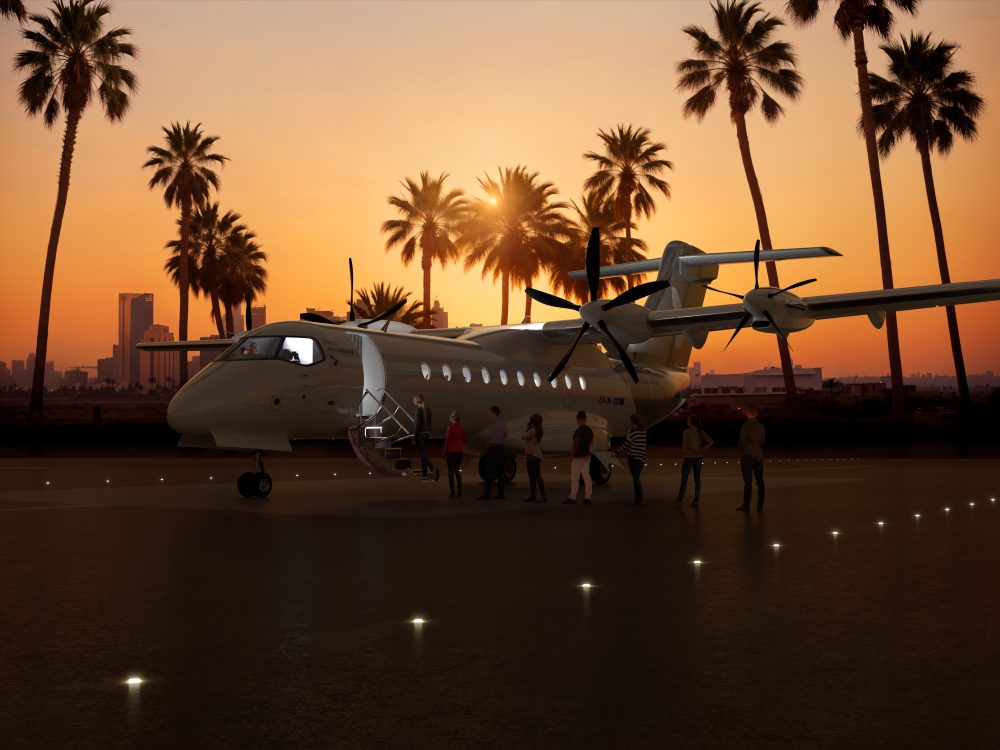Airlines are placing orders today for the passenger aircraft of tomorrow. Prototypes of the all-wing Z4 from Long Beach, California-based JetZero and the hybrid-electric ES-30 from Heart Aerospace have left the drawing boards and are in testing.
Production of the 250-seat Z4 will take place in a new facility on a site at Piedmont Triad International (PTI) Airport in Greensboro, North Carolina, JetZero announced on June 12. The more than $4 billion, 14,000-jobs project will get under way in 2026, and the company anticipates producing 20 aircraft per month when fully operational.
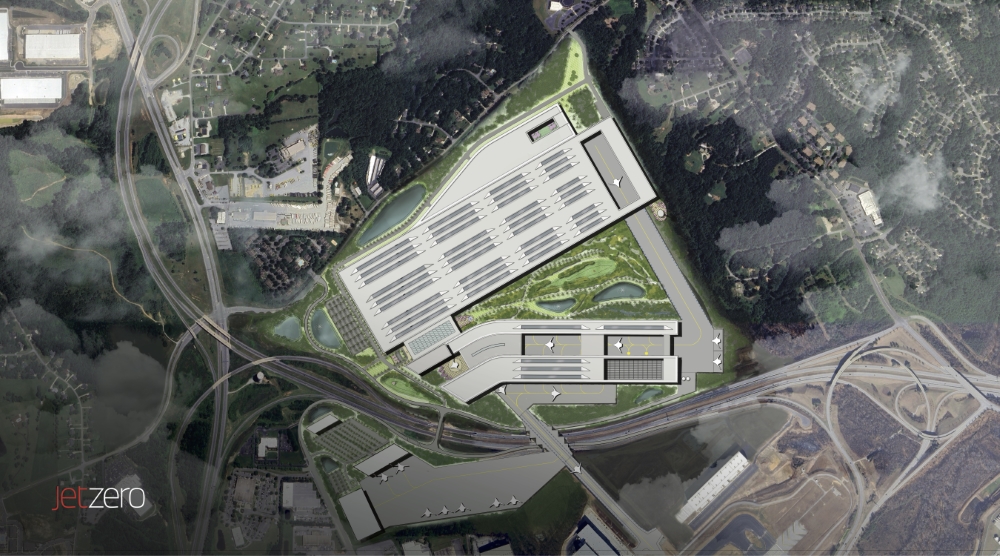
JetZero will build its Z4 all-wing commercial airliner in a new facility at Piedmont Triad International Airport in Greensboro, North Carolina.
Rendering courtesy of JetZero
“North Carolina offers the ideal combination of talent, infrastructure and forward-thinking leadership to support our mission to reshape aviation,” said Tom O’Leary, CEO and co-founder of JetZero, announcing the project.
JetZero is taking a clean-sheet approach to designing and building the factory, according to a company release.
“Working with Siemens including their Smart Infrastructure, Electrification, and Automation divisions, headquartered in North Carolina, JetZero is designing the greenfield factory to leverage the latest digital and industrial AI tools to ensure the most efficient and cost-effective production and operating model,” it explains. “Siemens also supports JetZero’s design/build/test model for the Demonstrator aircraft, a full-scale prototype slated for first flight in 2027. Siemens tools enable accelerated design, adaptable manufacturing, and digital test, shaving years of development time while upholding the highest quality and safety standards.”
Why an all-wing design? JetZero says the Z4 will deliver up to 50% better fuel efficiency with lift provided by the entire wingspan and lower drag compared to a tube & wing airplane. The Z4 airplane is designed to accommodate 250 passengers and fly on conventional jet fuel, with propulsion systems able to use sustainable aviation fuel blends, according to the company.
United Airlines has ordered 100 of the aircraft with an option for an additional 100. Alaska Airlines is investing in JetZero in a deal that includes options for future aircraft orders. And Delta Air Lines is partnering with JetZero as its Sustainable Skies Lab works on achieving net-zero emissions by 2050.
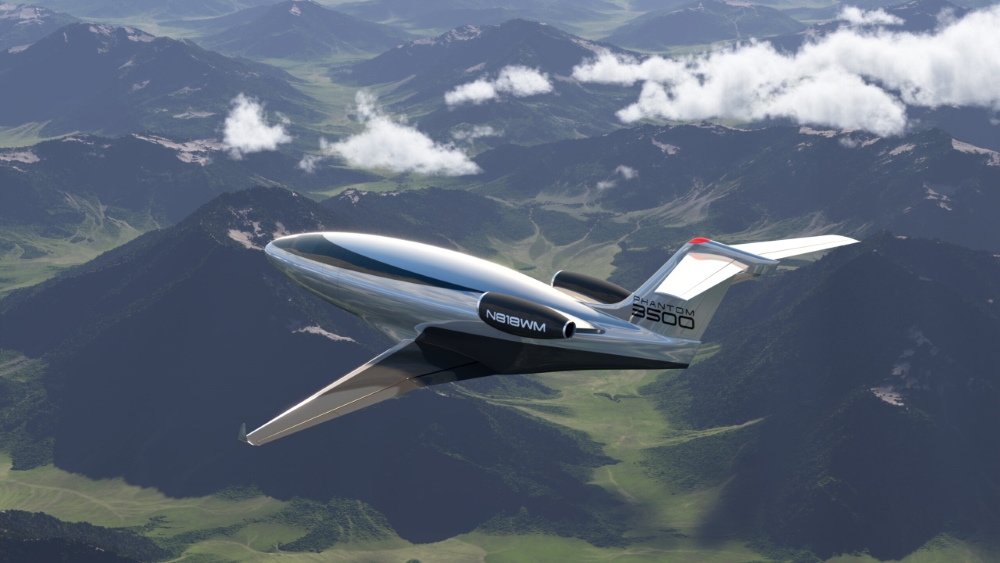
The windowless Phantom 3500 jet is being developed by Otto Aviation.
Photo courtesy of Otto Aviation
Electric Flight Company Moves to California
Meanwhile, Heart Aerospace, which is developing a hybrid-electric regional airliner, is pulling up stakes from its base in Gothenburg, Sweden, and establishing its new headquarters in Los Angeles, the company announced in April. The company has 250 firm orders for its ES-30 aircraft, which is scheduled to enter passenger production by the end of the decade. Its Heart X1 prototype is undergoing testing, and its X2 prototype is in development.
“By consolidating our operations in Los Angeles, we can accelerate development, strengthen collaboration and better position Heart Aerospace for the future.”
— Anders Forslund, Co-founder and CEO, Heart Aerospace
“We are deeply grateful to our team in Sweden for being part of this chapter of Heart’s journey, and for all the support we have received in Sweden,” said Anders Forslund, co-founder and CEO, announcing the headquarters relocation. “However, as our customers, partners and investors are increasingly based in the U.S, we see greater opportunity in focusing our resources here. By consolidating our operations in Los Angeles, we can accelerate development, strengthen collaboration and better position Heart Aerospace for the future.”
The company is banking on reinvigorating regional air travel by making it significantly less expensive for carriers that today mainly use regional jet aircraft on short flights. It says battery-electric aircraft such as the ES-30 will reduce total industry emissions by 22% by 2050.
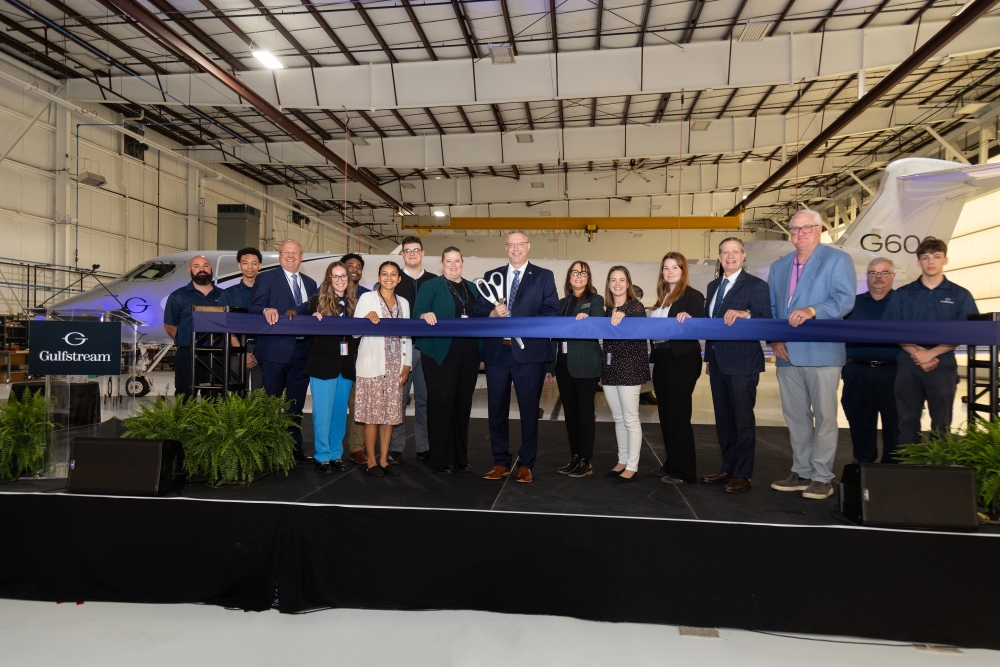
Gulfstream Aerospace Corp. opened its expanded aircraft completions operations at St. Louis Downtown Airport on May 1.
Photo courtesy of Gulfstream Aerospace
How far can it fly? An electric ES-30 carrying 30 passengers will have a range of about 120 miles. A hybrid-electric version with 30 on board will fly up to nearly 250 miles or nearly 500 miles with 25 passengers.
In May 2024, Heart Aerospace picked Los Angeles as the location of its R&D hub.
Northern Florida Adds Aerospace Investment
The Jacksonville Florida Times-Union reported on May 19 that aerospace startup Otto Aviation may build a manufacturing facility and headquarters at Cecil Airport, a former Navy airfield. The company currently is based in Fort Worth, Texas.
The company is developing the windowless Phantom 3500, which the company says is “the first true aircraft of the sustainability era. Featuring an AI-supported clean sheet design, transonic super-laminar flow architecture, cutting-edge aerodynamics, and a spacious cabin, the Phantom 3500 delivers unmatched fuel efficiency, reduced operating costs, and dramatically lower emissions, without compromising luxury or performance.”
In February 2024, Boeing opened its expanded maintenance, repair and overhaul (MRO) facility at Cecil Airport where F/A-18 Super Hornets, KC-46 tankers and other aircraft are maintained. The aerospace giant invested $248 million in the 385,000-sq.-ft. facility.
Elsewhere in northern Florida, the governor’s office on May 29 announced a more than $1 billion project in Okaloosa County, where Williams International will build a high-volume aviation gas turbine engine manufacturing facility in the Shoal River Industrial Park.
In 2022, Governor Ron DeSantis awarded $3.2 million through the Florida Job Growth Grant Fund to expand manufacturing in Okaloosa County, according to a release. FloridaCommerce partnered with several state and local organizations including CareerSource Florida, Florida’s Great Northwest, Space Florida, Okaloosa County and Triumph Gulf Coast on this major economic development win for Florida.
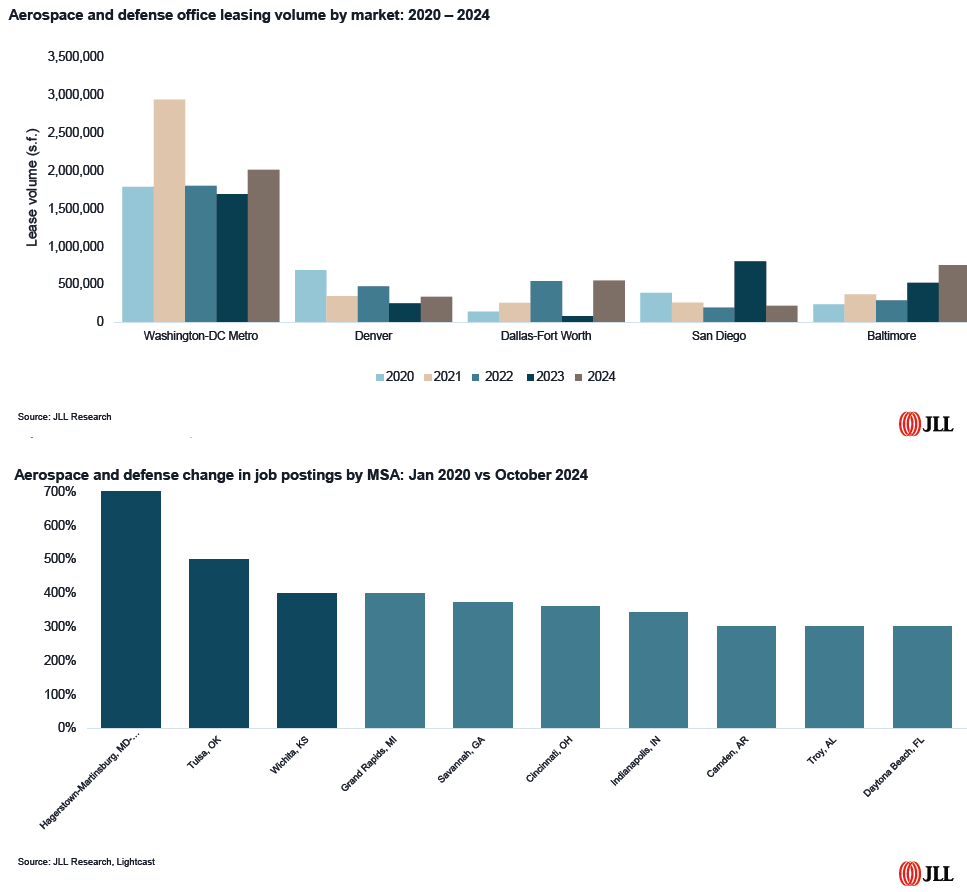
“We are seeing A&D firms consider a broader range of markets in their site selection process. The heightened competition in the industry is driving A&D firms to consider all markets that may lower operating costs, provide a business-friendly environment and help attract top talent.”
— Tom Taylor, Managing Director, Aerospace and Defense, JLL
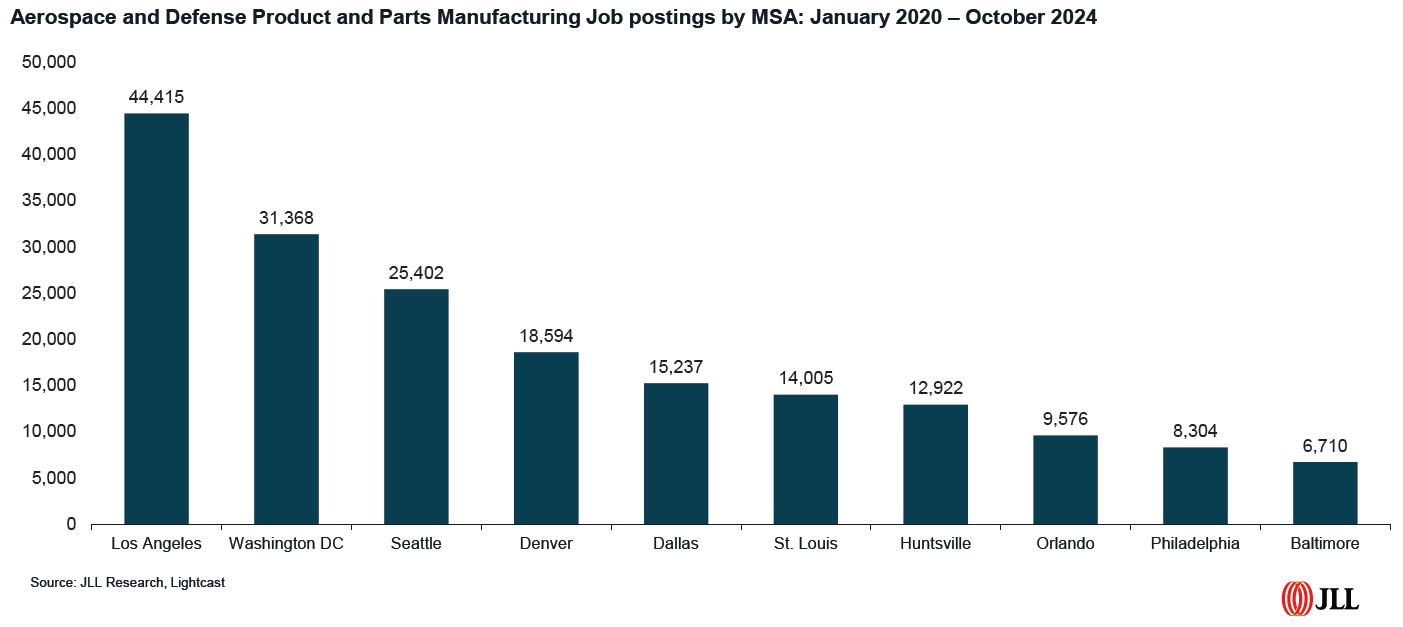
The three charts appear in the Q1 2025 Aerospace and Defense Industry Insights report from JLL.
“This billion-dollar investment is a major win for the Free State of Florida and for Floridians,” said Governor Ron DeSantis. “Williams International’s investment in the Florida Panhandle will create more than 330 jobs and is a success story of the Florida Job Growth Grant Fund in Northwest Florida.”
Gulfstream Aerospace Corp. said May 1 it finished the $30 million expansion of its aircraft completions operations at St. Louis Downtown Airport, adding to Gulfstream’s St. Louis MRO facility that opened in 2017 to provide dedicated hangar space and service to support the entire Gulfstream fleet. The company employs more than 675 team members on site in St. Louis and encompasses a total facility footprint of 645,013 sq. ft.
“The St. Louis area is a booming aviation hub filled with skilled and capable talent, and that has played a role in our continued investment in the region.”
— Mark Burns, President, Gulfstream
St. Louis Regional Freightway reports that the bi-state region has seen 11.9% job growth in the aerospace sector over the past five years.
“The St. Louis area is a booming aviation hub filled with skilled and capable talent, and that has played a role in our continued investment in the region,” said Gulfstream President Mark Burns.
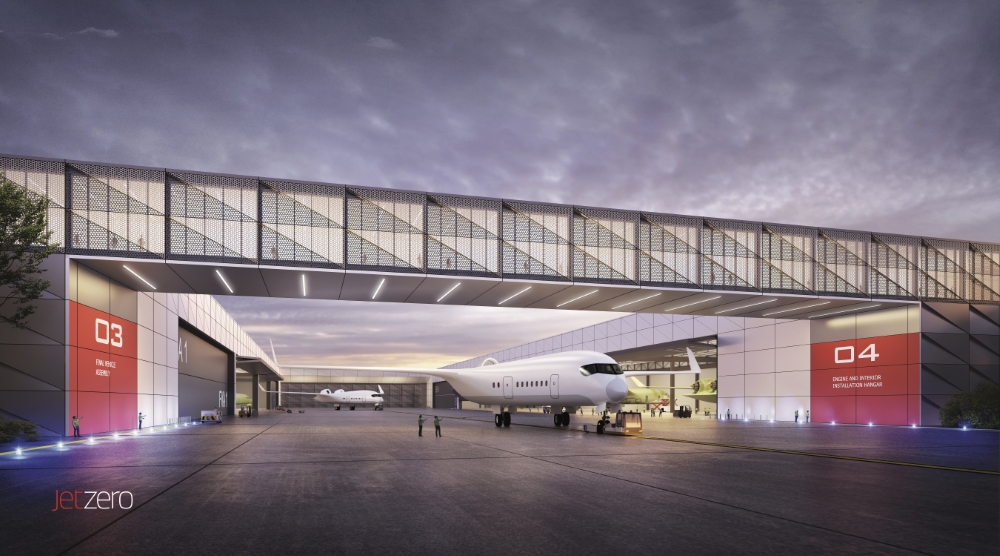
The States with the Best Aerospace Chops
Think of the State Hamilton Index, a May 2025 report from the Information Technology and Innovation Foundation (ITIF), as your state’s report card from the school of advanced industries. It ranks the 50 states and District of Columbia based on their share of employment and production output across 21 advanced industries, including aerospace parts and part manufacturing.
The Index uses ITIF used “an analytical statistic known as a location quotient (LQ), which “measures any region’s level of industrial specialization relative to a larger geographic unit — in this case, a state relative to the United States as a whole,” according to ITIF. It’s a visually compelling tool for seeing which states are overperforming in each industry and which states are underperforming.
“North Carolina offers the ideal combination of talent, infrastructure and forward-thinking leadership to support our mission to reshape aviation.”
Tom O’Leary, CEO and co-founder, JetZero
Twenty states are overperforming in the aerospace parts and part manufacturing category, three — Kansas, Washington and Connecticut — quite considerably. An LQ of 1 is the national average, and these three states score LQs of 10.99, 7.92 and 7.69, respectively, “reflecting their strong aerospace infrastructure and major industry players such as Boeing and Pratt & Whitney,” the report explains. “Other high-performing states include Arizona (3.76), Missouri (3.65) and Alabama (3.01), all of which have well-established aerospace clusters benefiting from government contracts, skilled labor and research institutions.”
As for aerospace employment, the report reveals, “Washington leads the aerospace product and parts manufacturing industry with 67,123 employees, establishing itself as the dominant hub. California has 62,267 workers, while Texas, home to SpaceX and many other NASA contracting firms, employs 41,535 employees. Connecticut and Kansas, which have high LQs, also play significant roles, employing 28,151 and 25,413 individuals, respectively. Employees in the aerospace industry are widely dispersed around the United States, with 26% of the nationwide workforce located outside the 10 largest states in the industry.”
